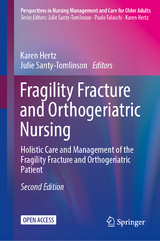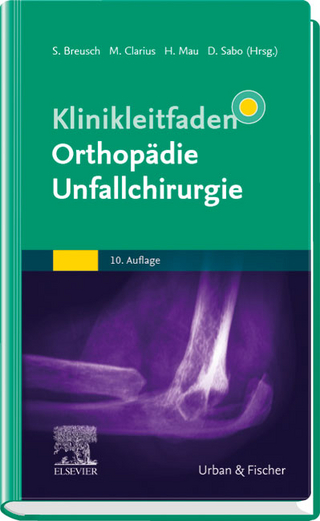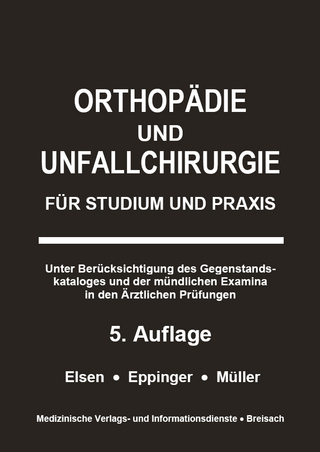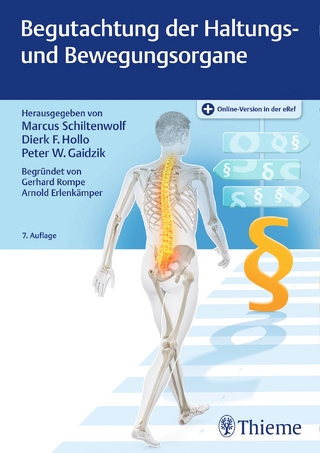
Fragility Fracture Nursing
Springer International Publishing (Verlag)
978-3-319-76680-5 (ISBN)
Globally, a fragility fracture is estimated to occur every 3 seconds. This amounts to 25 000 fractures per day or 9 million per year. The financial costs are reported to be: 32 billion EUR per year in Europe and 20 billon USD in the United States. As the population of China ages, the cost of hip fracture care there is likely to reach 1.25 billion USD by 2020 and 265 billion by 2050 (International Osteoporosis Foundation 2016). Consequently, the need for nursing for patients with fragility fracture across the world is immense. Fragility fracture is one of the foremost challenges for health care providers, and the impact of each one of those expected 9 million hip fractures is significant pain, disability, reduced quality of life, loss of independence and decreased life expectancy.
There is a need for coordinated, multi-disciplinary models of care for secondary fracture prevention based on the increasing evidence that such models make a difference. There is also a need to promote and facilitate high quality, evidence-based effective care to those who suffer a fragility fracture with a focus on the best outcomes for recovery, rehabilitation and secondary prevention of further fracture. The care community has to understand better the experience of fragility fracture from the perspective of the patient so that direct improvements in care can be based on the perspectives of the users.
This book supports these needs by providing a comprehensive approach to nursing practice in fragility fracture care.
Karen Hertz is is a registered nurse with extensive experience of clinical practice in a wide range of acute hospital settings with a focus on orthopaedic/trauma and orthogeriatric nursing as well as all aspects of adult nursing. She has developed a clinical career in the role of Advanced Nurse Practitioner in which she provides patient focused care, using advanced assessments skills and nurse prescribing privileges to provide autonomous clinical practice for patients within a trauma unit in a large University Hospital. She has a track record of national and international networking that includes membership of various boards and committees relevant to her practice and has co-authored several book chapters. Dr. Julie Santy-Tomlinson is a registered nurse with clinical interests in orthopaedics and trauma, wound management, tissue viability and nursing care of the older adult. She has worked in nursing education in the UK for over 20 years and currently works at the University of Manchester as a Senior Lecturer where she teaches a broad spectrum of nursing topics. She is also Editor in Chief of the International Journal of Orthopaedic and Trauma Nursing and has authored, co-authored and co-edited numerous journal papers, clinical guidelines, books and book chapters.
Foreword
Professor Paolo Falaschi, Italy and Professor David Marsh, United Kingdom
Preface
Karen Hertz and Julie Santy-Tomlinson
Chapter 1: Osteoporosis and the nature of fragility fracture - an overview
Marsha Van Oostwaard, Netherlands and Ana Cruz Tochon-Lauraz, Switzerland
- Aims of chapter - overall purpose
- Learning outcomes - what the nurse will be able to do at the end of the chapter
- What the nurse should know about:
- Fragility fracture
- Summary of main points for learning
- Suggested further study
- How to self-assess learning References
- Osteoporosis
Chapter 2: Frailty, sarcopenia and falls
Andrea Marques, Portugal and Carmen Queiros, Portugal
- Aims of chapter - overall purpose
- Learning outcomes - what the nurse will be able to do at the end of the chapter
- What the nurse should know about:
- Frailty
- Assessment
- Interventions
- Sarcopenia
- Assessment
- Interventions
- The link between frailty, sarcopenia and falls
- Suggested further study
- How to self-assess learning
- References
Chapter 3. Fracture and fall prevention and fracture liaison
Ana Cruz Tochon-Lauraz, Switzerland and Marsha Van Oostwaard, Netherlands
- Aims of chapter - overall purpose
- Learning outcomes - what the nurse will be able to do at the end of this chapter and following further study
- What the nurse should know about:
- Fracture and fall prevention
- Assessment processes
- Evidence based nursing interventions
- Fracture liaison <
- Assessment processes
- Evidence based nursing interventions
- Summary of main points for learning
- Suggested further study How to self-assess learning
Chapter 4: Comprehensive geriatric assessment from a nursing perspective
Mette Martinsen, Norway; Louise Brent, Ireland and Lina Spirgiene, Lithuania
- Aims of chapter - overall purpose
- Learning outcomes - what the nurse will be able to do at the end of this chapter and following further study
- What the nurse should know about:
- Comprehensive orthogeriatric assessment and its components Assessment processes - including the evidence base
- Summary of main points for learning
- Suggested further study
- How to self-assess learning
Chapter 5: Orthogeriatric nursing in the emergency and perioperative in-patient setting
Charlotte Myhre-Jensen, Denmark and Oliver Mauthner, Switzerland
- Aims of chapter - overall purpose
- Learning outcomes - what the nurse will be able to do at the end of this chapter and following further study
- What the nurse should know about:
- Emergency care
- Assessment
- Evidence based interventions
- Assessment
- Evidence based interventions
- Perioperative care
- Evidence based interventions
- Postoperative care
- Assessment
- Evidence based interventions
- Preoperative care
- Assessment
- Summary of main points for learning
- Suggested further study
- How to self-assess learning
Chapter 6: Mobility, remobilisation, exercise and prevention of the complications of stasis
Panagiota Copanitsanou, Greece
- Aims of chapter - overall purpose
- Learning outcomes - what the nurse will be able to do at the end of this chapter and following further study
- What the nurse should know about:
- Exercise
- The complications of stasis
- Mobility and remobilisation
- Evidence based interventions
- Exercise
- Assessment
- Evidence based interventions
- Assessment
- Evidence based interventions
- Summary of main points for learning Suggested further study
- How to self-assess learning
- Mobility & remobilisation
- Assessment
Chapter 7: Wound management and pressure ulcer prevention and management
Ami Hommel, Sweden and Julie Santy-Tomlinson, UK
- Aims of chapter - overall purpose
- Learning outcomes - what the nurse will be able to do at the end of this chapter and following further study
- What the nurse should know about:
- Pathophysiology and causes of pressure ulcers
- Wound management and surgical site infection following hip fracture surgery
- Pressure ulcer prevention
- Assessment
- Evidence based interventions
- Wound management and prevention of surgical site infection
- Assessment
- Evidence based interventions
- Summary of main points for learning
- Suggested further study How to self-assess learning
Chapter 8: Nutrition, hydration and elimination
Patrick Roigk, Germany
- Aims of chapter - overall purpose
- Learning outcomes - what the nurse will be able to do at the end of this chapter and following further study
- What the nurse should know about:
- Nutrition
- Hydration
- Elimination
- Assessment
- Evidence based interventions
- Hydration
- Assessment
- Evidence based interventions
- Elimination
- Assessment
- Evidence based interventions
- Suggested further study
- How to self-assess learning
Chapter 9: Nursing the patient with altered cognitive function
Karen Hertz, United Kingdom and Manuela Pretto , Switzerland
- Altered cognitive function and:
- Delirium
- Dementia
- Depression
- Assessment
- Evidence based interventions
- Assessment
- Evidence based interventions
- Assessment
- Evidence based interventions
Chapter 10: Patient motivation, rehabilitation, discharge and post-hospital care
Silvia Barberi, Italy and Lucia Mielli, Italy
- Aims of chapter - overall purpose
- Learning outcomes - what the nurse will be able to do at the end of this chapter and following further study
- What the nurse should know about:
- Rehabilitation
- Patient motivation
- Discharge
- Post-hospital care
- Rehabilitation
- Assessment Evidence based interventions
- Patient motivation
- Assessment
- Evidence based interventions
- Discharge
- Assessment
- Evidence based interventions
- Discharge
- Assessment Evidence based interventions
- Summary of main points for learning
- Suggested further study
- How to self-assess learning
Chapter 11: Family partnerships, palliative care and end of life
Louise Brent, Ireland
- Aims of chapter - overall purpose
- Learning outcomes - what the nurse will be able to do at the end of this chapter and following further study
- What the nurse should know about:
- Family partnerships
- Palliative Care
- End of life
- Assessment
- Evidence based interventions
- Assessment
- Evidence based interventions
- Assessment
- Evidence based interventions
Chapter 12: The orthogeriatric nursing and care philosophy across difference care settings
Magdalena Kaminska, Poland and Julie Santy-Tomlinson, United Kingdom
- Aims of chapter - overall purpose
- Learning outcomes - what the nurse will be able to do at the end of this chapter and following further study
- What the nurse should know about:
- The nature of orthogeratric nursing Links with adult and geriatric nursing theory and philosophy
- Professional, ethical, legal and political aspects of orthogeriatric nursing
- The value and availability of the nursing resource and its impact on care quality and patient outcomes
- The nursing role in audit and practice improvement
- Suggested further study
- How to self-assess learning
"This is a resourceful, insightful, thorough discussion of the care of geriatric patients with fractures. The focus on older patients is important because of the increased risk and occurrence of fractures in this population. The book will be an asset to anyone caring for the elderly." (Melody L.W. Schrock, Doody's Book Reviews, October, 2018)
“This is a resourceful, insightful, thorough discussion of the care of geriatric patients with fractures. The focus on older patients is important because of the increased risk and occurrence of fractures in this population. The book will be an asset to anyone caring for the elderly.” (Melody L.W. Schrock, Doody's Book Reviews, October, 2018)
| Erscheinungsdatum | 02.07.2018 |
|---|---|
| Reihe/Serie | Perspectives in Nursing Management and Care for Older Adults |
| Zusatzinfo | XX, 158 p. 5 illus., 3 illus. in color. |
| Verlagsort | Cham |
| Sprache | englisch |
| Maße | 155 x 235 mm |
| Gewicht | 379 g |
| Themenwelt | Medizinische Fachgebiete ► Chirurgie ► Unfallchirurgie / Orthopädie |
| Medizin / Pharmazie ► Medizinische Fachgebiete ► Geriatrie | |
| Medizin / Pharmazie ► Pflege ► Pflegemanagement / Qualität / Recht | |
| Pflege ► Studiengänge ► Pflegewissenschaft | |
| Schlagworte | Elderly trauma • Frail older person • Hip Fracture • open access • Orthogeriatric nursing • Osteoporosis |
| ISBN-10 | 3-319-76680-5 / 3319766805 |
| ISBN-13 | 978-3-319-76680-5 / 9783319766805 |
| Zustand | Neuware |
| Informationen gemäß Produktsicherheitsverordnung (GPSR) | |
| Haben Sie eine Frage zum Produkt? |
aus dem Bereich



